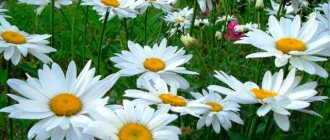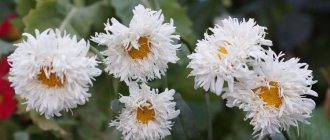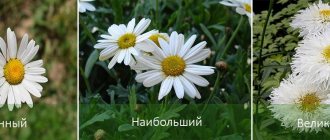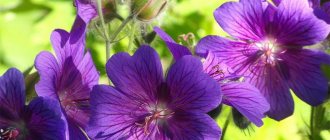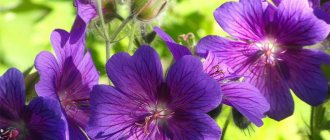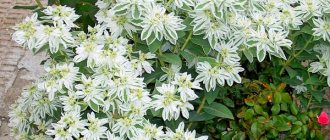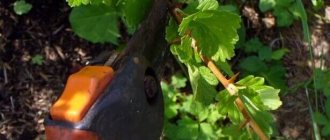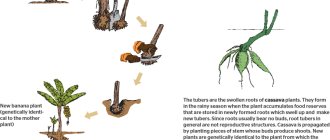Large (giant) garden chamomile is a very beautiful flower that decorates the garden for many years. It is unpretentious and does not require complex care. However, you should not neglect the following guidelines, since insufficient or irregular care can lead to dire consequences.
First of all, when caring for a large garden chamomile, you need to take into account three “golden” rules:
- avoid overwatering;
- prevent the expansion of weeds;
- Don’t forget to loosen the soil regularly.
Nevertheless, in plant care there are a number of special cases related to reproduction, preparation for winter “rest” and the prevention of fungal infections. What does a gardener who grows or decides to grow a large garden chamomile need to know so that the plant feels comfortable?
Morphological description
Large (giant) garden chamomile is a perennial herbaceous bush plant belonging to the Asteraceae (Asteraceae) family. Its peculiarity is large inflorescences, mainly with snow-white petals and a yellow core.
Often a large garden chamomile is called nevus. From a botanical point of view, this name is incorrect: daisy belongs to the same family, however, chamomile flowers are slightly smaller, and the leaves are thinner and more delicate, not whole.
Garden chamomile is a branched plant with many inflorescences on one bush. The buds are large, dense, pronounced. The stem is elastic and strong. A healthy plant can bloom all summer. In many cases, the morphology of garden chamomile is associated with belonging to one or another variety.
Echinacea
It won’t take long to remember the names of these multi-colored perennial “daisies,” since they are known to everyone for their healing properties. Their roots, stems and flowers are used in folk and official medicine to stimulate the immune system, as well as for the treatment of lymphocytic leukemia, the central nervous system and reproductive organs, viral and bacterial infections.
The plant has a straight stem that stretches up to 1.5 m, oval or linear-lanceolate leaves with jagged ends and daisy-like flowers. The peculiarity of the plant is also in the variety of petals: on the outer inflorescences they are long-tongued, barren, and on those located closer to the stem they are tubular and bisexual.
Did you know? From a hectare field of blooming echinacea, bees collect up to 130 kg of honey.
The plant begins to bloom in July and delights with new buds until October. In nature, there are 9 species of this culture, but only Echinacea angustifolia, purple and pale are used for medicinal purposes. For garden beds, varieties with pink and yellow petals are more often used.
Popular types and varieties of large garden chamomile.
Nivyanyk
A giant of its kind, the stem reaches 90 cm in height , and the diameter of the opened bud is more than 15 cm. Frost-resistant, easily tolerates drought. But for the most spectacular flowering, regular watering is necessary.
In addition to its aesthetic qualities, cornflower is known for its healing qualities. Most often used for cutting. This variety includes Terry chamomile , a perennial plant distinguished by an abundance of petals filling the core. Terry chamomile is practically not inferior to the largest variety - cornflower, reaching 70 cm in height.
North Star
A favorite of gardeners, it is distinguished by its resistance to drought, its size (stem length is 60-70 cm) and the shining whiteness of its inflorescences. It is not recommended to plant seedlings in shady corners of the garden. Planting seedlings is possible in spring or autumn, however, flowering occurs only in the second year.
Princess
Sun-loving perennial with lush white inflorescences. It reaches a height of no more than 35 cm with a diameter of the opened bud up to 10 cm. Unlike the Northern Star, the Princess prefers moist soil. The flowering period is the longest: from July to mid-October.
Alaska
Large-flowered plant reaching 90 cm in height. The diameter of the inflorescence is up to 12 cm. It is planted, as a rule, in the fall and will delight you with flowering the following summer. The variety is unpretentious, tolerates drought and, like its “botanical brothers,” loves sunlight.
Colored varieties
Thanks to the experiments of breeders, there are more than 100 colorful species, among which the most popular are:
- Pyrethrum pink or Persian chamomile has many varieties, differing in the richness of the color of the petals. It is often grown for cutting, harmonizing in a bouquet with other field plants. For Persian chamomile, both a lack and an excess of moisture are detrimental. Feels comfortable in the shade. The flowering period lasts all summer.
- Red pyrethrum is similar to pink, which often leads to confusion. Its peculiarity is its large bright red inflorescences, which is why it is sometimes called meat-red pyrethrum.
- Yellow doronicum is a perennial variety distinguished by the bright yellow color of its petals. Flowering occurs early - in the second half of March. During this period, the plant reaches 70 cm in height. Yellow doronicum multiplies quickly, without requiring specific care. Tolerates frosts. It is unpretentious to lighting and blooms longer in shady corners of the garden.
- Separately, it is worth mentioning blue chamomile , which is distinguished by the dark blue color of its inflorescences. This is an annual plant reaching 60 cm in height. It is best known for its use in medicine and cosmetology for the preparation of essential oil.
- Orange chamomile (or orange chamomile) is a perennial herbaceous plant with narrow bright orange petals. Sun-loving variety, grows quickly. Used to decorate flower beds, less often for cutting.
Photo gallery: variety of colors of colored chamomile
Growing on site
There are several ways to grow garden chamomile. Which method to choose depends on what time of year the planting takes place.
Seedling growing method
- a depression of up to 30 cm is made in the ground;
- Fertilizer is placed in the hole: compost or organomineral mixture;
- There is no need to remove old soil from the roots to avoid damage;
- The soil must be irrigated after planting.
Flowering should begin next year , but much depends on the characteristics of the variety.
Dividing the bush
It is better to plant by dividing the bush in the first half of autumn once every 2-3 years. Planting a flower is necessary for more spectacular flowering, which fades as the bush grows.
- the rhizome is divided into parts with several growth points;
- the seat should be slightly larger in size than the rhizome of the plant being planted;
- It is advisable to pre-fertilize the hole and straighten the root;
- After planting, the soil is compacted and watered.
Flowering occurs the following year.
If chamomile is grown for cutting and to form bouquets, the most suitable growing method is division.
Growing from seeds
Tips for growing large chamomile with seeds:
- To collect seeds, you need to wait until the flower stalks ripen (the petals should dry out and the baskets should turn brown).
- Cut and dry the inflorescences.
- Dry the seeds and remove debris from them.
- It is recommended to store seeds in a paper bag with an air hole.
Sowing period is autumn and spring.
Sow chamomile as follows:
- seeds are sown to a depth of no more than 2 cm;
- distance between rows – 20 cm;
- It is recommended to mulch the beds.
It is not recommended to make a flower garden in a shady place. Spring sowing will produce seedlings by autumn that can be transplanted.
How to plant a large garden chamomile in the garden?
Preparing the soil and choosing a planting site:
- Before planting the plants, the soil is fertilized (compost - at least 1 bucket per 1 square meter, mineral fertilizers).
- For planting large garden crops, it is preferable to choose slightly acidic soils; otherwise, dolomite flour or slaked soda is added.
- The bushes need space, since garden chamomile can grow without changing place for 3-5 years;
- The landing site should be sunny.
- Under no circumstances should you choose a wetland - this will lead to the occurrence of diseases.
When and how to plant?
- Sowing of seeds takes place at the end of May - end of July.
- To grow seedlings, seeds are sown in March in specially prepared pots with drainage (or ordinary plastic cups, but we must not forget to make a hole from the bottom).
- Planting by dividing the rhizome is carried out in September - early October.
- Seedlings are planted in May.
When is the best time to replant garden chamomile?
It is recommended to replant in the autumn, in the first half, after flowering, when there is young growth. Replanting is also possible at the end of spring, when there is no longer frost.
The plant takes root well, but for more spectacular flowering, when replanting, add mineral fertilizers or compost to the hole.
Planting pyrethrum
Sowing seeds should be done no earlier than April. This is due to the heat-loving nature of the flower. At night, it is recommended to cover the plant with film. This is necessary in order to protect it from possible frost. Seeds are sown at a shallow depth. At the same time, it is worth planting them as rarely as possible. When the first shoots appear, it is necessary to break through them. A distance of at least eight centimeters is left between the remaining plants. However, over time, the flowers need to be planted at a distance of 40-45 centimeters. Sown in the soil in the spring, pyrethrum will bloom only the next season.
It is noteworthy that the seeds of this crop are very small. Experts recommend mixing them with sand to facilitate the sowing process. However, there is an even simpler method. In this case, the seeds are distributed over the surface of the soil mixture and then sprinkled with the required amount of soil. It is recommended to water the crops using a fine spray bottle.
Caring for large garden chamomile
Watering and fertilizing
The plant needs regular, but not excessive watering. We must not forget to mulch or drain the soil. Fertilizers are suitable both organic and mineral.
Mandatory feeding:
- nitrophoska – 2 tbsp. l. fertilizers/10 liters of water (composition for May feeding);
- superphosphate or potassium sulfate - 1 tbsp. l/10 l of water.
Care after flowering and preparation for winter
After flowering ends, the plant also requires watering and loosening of the root soil. We must not forget to destroy the weed. With the end of flowering, new leaves appear in place of dead leaves, so the plant requires regular fertilization. Well suited for this: fresh mullein or an infusion of bird droppings.
As a rule, large garden chamomile can withstand frost in open ground, but it is better not to risk it and cover the garden bed with leaves before the snow falls.
Bush pruning and rejuvenation
To strengthen the rhizome and form new growth, it is not recommended to leave the stems standing - they must be cut off. After the chamomile has bloomed, the entire above-ground part of the plant is cut down to 10-15 cm from the ground.
Bush rejuvenation is pruning of part of the root system, performed 5 years after planting, and then repeated after 3 years.
How is rejuvenation performed:
- the rhizome is divided in half, one part of the root system is removed;
- In place of the removed part of the rhizome, compost and new fertile soil are laid.
During subsequent rejuvenation, the older part of the rhizome is removed.
Diseases and pests
If not properly cared for, large garden chamomile is susceptible to fungal infections:
- rust (the appearance of red spots on the surface of leaves);
- gray rot (damage is possible due to high soil moisture; brown spots with a gray coating form and grow on the stem and leaves);
- fusarium (damage to the root system; the plant quickly withers and dies);
- powdery mildew (a white coating appears on the leaves and stems, subsequently the affected parts become brown).
Fungicides are used to prevent infections. In case of severe damage, it is better to remove the plant.
The most dangerous pests:
- aphid : the plant becomes deformed, withers and dies;
- star-winged fly : appears when the flowerbed is overgrown with weeds; insect larvae occupy the plant, preventing it from developing;
- wireworm : can parasitize the rhizome, eating it;
- Harm is also caused by snails and slugs , which consider the plant appetizing.
Timely weeding and loosening of the soil, as well as preventive treatment with insecticides, will help reduce the risk of pest damage.
Growing nevus seedlings from seeds at home
Gardeners who are planning to plant cornflower seedlings at home begin work at the end of winter. They operate according to the following scheme:
- Gravel is poured into the bottom of the prepared containers.
- Nutrient soil is laid on top of the drainage.
- Carry out watering.
- Planting material is evenly distributed on the surface of the earth.
- Sprinkle with soil.
- Cover with film until shoots appear.
As soon as the sprouts appear on the surface of the soil, the cover is removed and standard care is carried out for the seedlings until they are planted in the flowerbed.
Large garden chamomile in landscape design
The large garden chamomile is famous in floristry and is used to decorate garden plots and flower beds, where it combines well with other garden flowers. It goes well with unpretentious wildflowers such as poppies, cornflowers, and bluebells.
Nivyanik goes well in one composition with flowers such as lilies. In addition, the plant feels comfortable on the Moorish lawn. Low-growing varieties decorate borders. Sometimes I grow garden chamomile in decorative flowerpots on terraces.
The success of this plant in modern landscape design lies in the duration of flowering and friendliness in relation to other garden plants, with which they form group plantings.
Large chamomile in garden design
Features of the plant
Garden chamomile is a very beautiful flower that can decorate any landscape design. Chamomile belongs to the category of herbaceous plants that love light.
This plant is characterized by the presence of straight, slightly branched stems, the height of which ranges from 80 to 100 centimeters. The foliage on the stem is arranged in a regular order. It is green in color and characterized by integrity.
The inflorescence of garden chamomile looks like large baskets, which are located at the ends of the stems.
The flowers have a yellow core, along the diameter of which the petals are arranged in one or several rows. The color of a garden chamomile petal can be varied: blue, pink, lilac, yellow, etc. Most often, garden chamomile has white petals.
Interesting Facts
- According to the modern dream book, if you dream of large chamomile flowers , a joyful event will happen soon, and weaving a wreath of daisies means happiness with your loved one.
- Large garden chamomile is a real find for florists : it does not fade in a bouquet for up to 10 days.
- Chamomile is a symbol of light, purity and fidelity , so it is no coincidence that it was chosen as the subject of fortune telling; For these purposes, since ancient times, the largest inflorescences have been selected, which established the plant as the most valued by lovers.
- Garden chamomile, like medicinal chamomile, easily relieves inflammation , has an antibacterial and sedative effect, and is also used to prepare teas and decoctions.
Advice from flower growers
- For propagation, it is better to choose a double variety of garden chamomile, since the flowers are larger and more beautiful, there are always many buds, and re-blooming is possible at the end of summer.
- Despite its frost resistance and hardiness, the flower can freeze in a winter with little snow, so it is sprinkled with a thick layer of peat, straw, and covered with spruce branches.
- Chamomile gets along well with any ornamental plant: with the beautiful lily and rose, field poppy and cornflower.
- In the search engine results for the query “garden chamomile, large perennial planting and care,” sometimes there are articles devoted to chamomile, which is a related, but still completely different medicinal wild plant. The technology of its cultivation and use differs from decorative chamomile. Therefore, you should carefully read the text of the article to determine what type of chamomile (decorative or medicinal) we are talking about.
Garden chamomile is considered not only an adornment to any landscape design, but in many ways it brings love and good luck to the house, where household members begin to live in peace and harmony. Combining well in height and size with other flower crops, it fits harmoniously into any flower garden, giving it a unique and eye-catching appearance.
1 1 vote
Article rating
